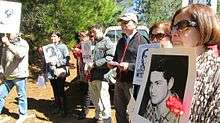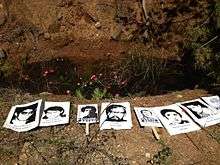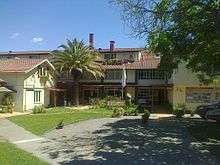Villa Baviera
| Villa Baviera | |
|---|---|
| Sect's operation place used as concentration camp by DINA | |
 | |
 Location of Villa Baviera in Chile | |
| Coordinates | 36°23′13″S 71°35′17″W / 36.38694°S 71.58806°WCoordinates: 36°23′13″S 71°35′17″W / 36.38694°S 71.58806°W |
| Other names | Colonia Dignidad |
| Known for | Internment of Pinochet's dissident during his military dictatorship |
| Location | 35km east of Parral |
| Built by | Paul Schäfer's sect |
| Operated by | Paul Schäfer |
| Commandant | Paul Schäfer |
| First built | 1961 |
| Operational |
1961 - 2007 (as sect's operation place)[1] 1973 - 1985 (as concentration camp of Pinochet's dissidents) |
| Killed | unknown |
| Notable inmates | Boris Weisfeiler (alleged) |
| Notable books | Das Blendwerk: Von der "Colonia Dignidad" zur "Villa Baviera" |
Villa Baviera (English: Bavaria Village) is the current organization occupying the location of the infamous and disgraced Colonia Dignidad (English: Dignity Colony), in Parral Commune, Linares Province,[2][3] in the Maule Region of central Chile. Located in an isolated area, Colonia Dignidad was ~35 km southeast of the city of Parral, on the north bank of the Perquilauquén River. Colonia Dignidad was founded by German émigrés in the mid-1950s,. Its most notorious leader, Paul Schäfer, arrived in the colony in 1961.[4] The full name of the colony from the 1950s was Sociedad Benefactora y Educacional Dignidad (English: Dignity Charitable and Educational Society). At its largest, Colonia Dignidad was home to some three hundred German and Chilean residents, and covered 137 square kilometers (53 sq mi).[5] The main legal economic activity of the colony was agriculture; at various periods it also was home to a school, a hospital, two airstrips, a restaurant, and a power station.
Colonia Dignidad's longest continuous leader, Schäfer, was a fugitive, accused of child molestation charges in the former West Germany. The organization he led in Chile was described, alternately, as a cult or as a group of "harmless eccentrics". The organization was secretive, and the Colonia was surrounded by barbed wire fences, and featured a watchtower and searchlights, and was later reported to contain secret weapon caches. In recent decades, external investigations, including efforts by the Chilean government, uncovered a history of criminal activity in the enclave, including child sexual abuse.[6] As well, the findings include that its legal activities were supplemented by income related to weapons sales and money laundering. Bruce Falconer, writing in a piece entitled "The Torture Colony" (in The American Scholar), and referencing Chile’s National Commission for Truth and Reconciliation, has reported that a small set of the individuals taken by Pinochet's Dirección de Inteligencia Nacional during his rule were held as prisoners at Colonia Dignidad, some of whom were subjected to torture, and that some Colonia residents of the time were participants in the atrocities.
The population of this location was 198 in the census of 2002. As of 2005, a colony remains on the site, using the site, with its leaders insisting that it is a different, changed organization. Its current leaders have attempted to modernize the colony, allowing residents to leave to study at university, and opening the colony to tourism.
History
The first inhabitants of Colonia Dignidad arrived in 1961, brought by German citizen Paul Schäfer, who was born in 1921, in the town of Siegburg near Bonn. Schäfer's first employment in Germany was as a welfare worker for children in an institution of the local church, a post from which he was fired at the end of the 1940s; he then faced accusations of sexual abuse against children in his care. While these first reports led to his dismissal, no criminal proceedings were initiated. He worked next as an independent preacher. Forming a community in Gronau, an organization dedicated to working with children at risk. He quickly acquired great influence over his members, who had to perform hard farm work without pay. Shortly thereafter, stories reemerged relating to the earlier allegations of pedophilia against him. As a result, Schäfer organized in 1961 the emigration of several hundred members of their community to Chile.
Problem observed
The colony intended to project to the outside world an image of harmony, order and an inclusive system of communal work. This was emphasized by the work of its own press operations who were recording and broadcasting videos showing their happy residents amid celebrations and commemorations: men dedicated to farm work, women and girls embroidering or preparing butter.
However, Schäfer propaganda efforts were again and again overshadowed by allegations of people escaping from the colony and obtaining asylum in Germany. The first, Wolfgang Muller, fled in 1966 and first exposed the atrocities that occurred within the colony. Muller obtained German citizenship and worked in a newspaper, soon becoming an activist in Germany against the leaders of Colonia Dignidad, and finally became the president of the foundation dedicated to the support of victims in Chile.
In the following year, he freed another inhabitant of the colony, Heinz Kuhn, who confirmed the allegations previously made by Müller, and provided more information on abuses. However, these first allegations were rejected by politicians and were emphatically denied due to their ties with the management of the Colony in their preparation of the military coup of September 11, 1973, as demonstrated later in Chilean court cases.
Secret detention camp
The Rettig Commission noted a wealth of information supporting the accusations of the use of the laundry owned by Colonia Dignidad for detention and torture of political detainees during Pinochet's military dictatorship. This farm, commonly known as Colonia Dignidad, is within Parral, on the banks of river Perquilauquén, near Catillo. The Commission has also noted that other sources concluded Colonia Dignidad was used, at least, as a detention center for political prisoners. Among these sources are spokesmen for the Government of the Federal Republic of Germany, and the Working Group on Forced Disappearance of Persons of the United Nations. The Rettig Commission ultimately based its conclusions on evidence that it examined directly.
Claims of Bundesnachrichtendienst assistance
Journalist John Dinges has claimed that there was some degree of cooperation between the Bundesnachrichtendienst (German Intelligence Service) and Colonia Dignidad, including creation of bunkers, tunnels, a hospital, and runways for the decentralized production of armaments in modules (parts produced in one place, other parts in another). This subject was proactively hidden, because of the problems experienced at the time associated with Argentina.
Democratic transition
Chile took a turn to democracy in 1990 after 17 years of dictatorship, but Colonia Dignidad remained unchanged. Allegations of abuses and humiliations that occurred inside the colony increased. National and international pressure intensified, but each time the police tried to conduct an investigation at the site they were greeted with a wall of silence. Colonia Dignidad authorities remained powerful and also had allies in the army and among the Chilean far-right, who would warn them in advance when the police were preparing to visit the site.
Slowly, Chilean public awareness began to change, creating a growing feeling of resentment towards the place, which many began to perceive as an independent state, or an enclave within Chile.
Life under Schäfer leadership
The inhabitants lived under an abnormal authoritarian system, where in addition to minimal contact with the outside, Schäfer ordered the division of families (parents did not talk to their children, or did not know their siblings). It prohibited all kinds of relations, sentimental or conjugal, among adult women and men, and enacted the residence of each sex in isolated areas. Schäfer sexually abused children and some were tortured, as is clear from the statements of the German Dr. Gisela Seewald, who admitted the use of electroshock therapy and sedatives that her boss had claimed were placebos.
In stark contrast, however, the colony had a school and hospital in the enclave which offered support to rural families through free education and health services. This would, ultimately, create support in case the colony was attacked. However, there are many cases uncovered in recent years that refer to illegal adoptions of children from families residing in the surrounding areas by the German hierarchy in order to deliver on the promise of free education.
Accusations of atrocities
Sex Abuse
In 1996, Schaefer fled child sex abuse charges in Chile[7] and wasn't arrested until 2005. The previous year, in his absence, a Chilean court had convicted him of child abuse, together with 26 other cult members.[8] In 2006, he was sentenced to 20 years in prison.[9] He died in prison of a heart ailment, on 24 April 2010, at the age of 89. At the time of his death he was still under investigation for the 1985 disappearance of mathematician Boris Weisfeiler, an American citizen who went missing while hiking near Colonia Dignidad.[10]
Torture


During the military dictatorship of Augusto Pinochet the Colonia Dignidad served as a special torture center. In 1991, Chile’s National Commission for Truth and Reconciliation concluded “that a certain number of people apprehended by the DINA were really taken to Colonia Dignidad, held prisoner there for some time, and that some of them were subjected to torture, and that besides DINA agents, some of the residents there were involved in these actions.”[11] The March 1977 Amnesty International report, "Disappeared Prisoners in Chile", referencing a U.N. report, refers to the evidence in this way:
Another… detention center described in the [U.N.] document, in which it is alleged that experiments in torture are carried out, is Colonia Dignidad, near the town of Parral…[2]
Member abuse
Some defectors from the colony have portrayed it as a cult in which the leader Paul Schäfer held the ultimate power. They claim that the residents were never allowed to leave the colony, and that they were strictly segregated by gender. Television, telephones and calendars were banned. Residents worked wearing Bavarian peasant garb and sang German folk songs. Sex was banned, with some residents forced to take drugs to reduce their desires. Drugs were also administered as a form of sedation, mostly to young girls, but to males as well. Severe discipline in the forms of beatings and torture was commonplace: Schäfer insisted that discipline was spiritually enriching.
There are more than 1,100 desaparecidos (disappeared persons) in Chile, many taken to the Colony where they were tortured and killed. One of them is a U.S. citizen, Boris Weisfeiler, a Soviet-born mathematics professor at Pennsylvania State University. Weisfeiler vanished while on a hiking trip near the border between Chile and Argentina in the early part of January 1985. It is presumed that Weisfeiler was kidnapped and taken to the Colony where he was tortured and killed.[12] In 2012, a judge in Chile ordered the arrest of eight former police and army officials over the kidnapping of Weisfeiler during the Pinochet years, citing evidence from declassified US files.[13]
Weapons violations
In June and July 2005, Chilean police found two large illegal arms caches in or around the colony. The first, within the colony itself, included three containers with machine guns, automatic rifles, rocket launchers, and large quantities of ammunition, some as many as forty years old but with evidence of recent maintenance.[14][15] This cache was described as the largest arsenal ever found in private hands in Chile. The second cache, outside a restaurant operated by the colony, included rocket launchers and grenades.
In January 2005, former Chilean secret police operative Michael Townley, then living in the United States under a witness-protection program, acknowledged to agents of Interpol Chile links between DINA and Colonia Dignidad. Townley also revealed information about Colonia Dignidad and the army's Laboratory on Bacteriological Warfare. This last laboratory would have replaced the old DINA's laboratory at Vía Naranja de Lo Curro hill, where Townley worked with the chemist Eugenio Berríos. Townley also gave proof of biological experiments, related to the two aforementioned laboratories, on political prisoners at Colonia Dignidad.[16]
Nazi ties
Both the Central Intelligence Agency and Simon Wiesenthal have presented evidence of the presence at the colony of the infamous Nazi concentration camp doctor Josef Mengele, known as the "Angel of Death" for his lethal experiments on human subjects during the Holocaust.[17]
Legal proceedings
On 25 May 2011, journalist Amanda Reynoso-Palley reported in The Santiago Times that Hartmutt Hopp, an authority in the colony, fled Chile on board a helicopter and was believed to be in Germany. Hopp, under house arrest in Chile while awaiting trial for human rights crimes, was the "right-hand-man to Paul Schäfer, the former Nazi and founder of the Colonia Dignidad (Colony of Dignity)."[18] In June 2016, prosecutors in Germany petitioned a court to enforce a 5-year prison sentence that Hopp was sentenced to in absentia in Chile.[19][20]
On 28 January 2013, six former leaders of the colony were sentenced to prison by Chile’s Supreme Court, but the case, which prosecuted Chilean and German citizens for crimes committed in the 1990s, was not over yet, according to a story appearing the following day in The Santiago Times filed by staff reporters.[21]
Villa Baviera era




As of 2005, there is still a colony on the site, but its current leaders insist that changes have taken place. Current leaders have attempted to modernize the colony, allowing residents to leave to study at university and opening the colony to tourism.[3]
See also
References
- ↑ http://www.giornalettismo.com/archives/102268/villa-baviera-colonia-dignidad/
- 1 2 Amnesty Staff (1977-03-01). "Disappeared Prisoners in Chile". Amnesty International. Retrieved 21 April 2016.
Another DINA detention center described in the same document, in which it is alleged that experiments in torture are carried out, is Colonia Dignidad, near the town of Parral, in Linares Province,
- 1 2 "Villa Baviera: Chile's Torture Colony Tourist Trap". Bloomberg.com. Retrieved 2016-09-05.
- ↑ Infield, Glenn, Secrets of the SS, 1981, p. 206.
- ↑ "BBC NEWS - Americas - Secrets of ex-Nazi's Chilean fiefdom". bbc.co.uk. Retrieved 21 April 2016.
- ↑ "The Colony: Chile's dark past uncovered". AlJazeera. December 15, 2013. Retrieved January 24, 2014..
- ↑ Hannaford, Alex. "What happened in Colonia?". The Telegraph. Retrieved 7 September 2016.
- ↑ Harding, Luke (2005-03-12). "Fugitive Nazi cult leader arrested". The Guardian. London. Retrieved 2008-04-02.
- ↑ Conway, Jane. "German Cult Leader in Chile Gets 20-Year Sentence". Deutsche Welle. Retrieved 7 September 2016.
- ↑ Brown, Emma (April 27, 2010). "Paul Schaefer, 89, ex-Nazi preacher jailed for abuse, dies". Washington Post. Retrieved 7 September 2016.
- ↑ Falconer, Bruce (2008-09-01). "The Torture Colony". The American Scholar. Retrieved 21 April 2016.
- ↑ "Professor Boris Weisfeiler: Missing in Chile since 1985". weisfeiler.com. Retrieved 21 April 2016.
- ↑ "Judge in Chile orders arrests over missing US hiker". BBC News. Retrieved 21 April 2016.
- ↑ Arsenal encontrado en Colonia Dignidad, noticia reproducida en War2Hobby, 16.06.2005; acceso 04.02.2012
- ↑ Policía civil encontró dos depósitos de armas en ex Colonia Dignidad, Radio Cooperativa, 14.06.2005; 04.02.2012
- ↑ "Michael Townley fue interrogado por muerte de Frei Montalva". Cooperativa.cl. Retrieved 21 April 2016.
- ↑ Infield, Secrets, p. 207.
- ↑ "Human Rights & Law News: "Colonia Dignidad Cult's Second-In-Command Flees Chile"". The Santiago Times. May 25, 2011. Retrieved February 28, 2015.
- ↑ Stirken, Norbert. "Sektenarzt aus Krefeld: Hopp könnte laut Regierung Täter und Opfer zugleich sein". RP ONLINE. Retrieved 2016-09-05.
- ↑ "German court asked to jail Chile sect doctor Hartmut Hopp - BBC News". Retrieved 2016-09-05.
- ↑ "Chile Abroad: Colonia Dignidad victims file US $120 million lawsuit against Chile". The Santiago Times. 2 January 2013. Retrieved 28 February 2015.
Bibliography
- Infield, Glenn (1981). Secrets of the SS. New York, NY: Stein and Day. ISBN 0812827902.
Further reading
The following citations are presented in inverse date order, newest published to oldest. They are offered for improvement of the article, and to allow readers further information on the subject.
- Douglas, Marcela. "Hopes and Horror. A German community in Chile." UiT The Arctic University of Norway, 2014. ISBN 9788282441148.
- "Tales of torture: A former member of Chile's national intelligence agency describes some of the methods used against political prisoners". AlJazeera. December 15, 2013. Retrieved January 24, 2014.. The relevance of this article us uncertain.
- Levenda, Peter (Kindle ed., 2012). Ratline: Soviet Spies, Nazi Priests, and the Disappearance of Adolf Hitler. Ibis Press. ASIN B0081HDYQ6.
- Klaus Schnellenkamp. Geboren im Schatten der Angst, Ich überlebte die Colonia Dignidad. München: Herbig Verlagsbuchhandlung, 2007, 238 S., ISBN 9783776625059.
- Heller, Friedrich Paul. Lederhosen, Dutt und Giftgas: Die Hintergründe der Colonia Dignidad. Stuttgart: Schmetterling Verlag, 2005. ISBN 3-89657-093-5
- Vedder, Efrain & Lenz, Ingo. Weg vom Leben. Berlin: Ullstein, 2005, ISBN 3550076134.
- "BBC NEWS - Americas - German held over 'Chile torture'". bbc.co.uk. 27 December 2005. Retrieved 21 April 2016.
- "BBC NEWS - Americas - Chile officials take over colony". bbc.co.uk. 27 August 2005. Retrieved 21 April 2016.
- "Chile discovers weapons cache on cult grounds". The New Zealand Herald. 16 June 2005. Retrieved 21 April 2016.
- "BBC NEWS - Americas - Fugitive Chile cult leader held". bbc.co.uk. 11 March 2005. Retrieved 21 April 2016.
- Peter Kornbluth, The Pinochet File: A Declassified Dossier on Atrocity and Accountability, Boris Weisfeiler, pp. 7 e.a. New York: The New Press, 2003, ISBN 9781595589958.
- Gero Gemballa: Colonia Dignidad. Ein Reporter auf den Spuren eines deutschen Skandals. Frankfurt/New York: Campus-Verlag, 1998, 213 S., ISBN 3593359227.
- Levenda, Peter (1995). Unholy Alliance: History of the Nazi Involvement With the Occult, 1st edn., Avon Books. ISBN 0380777223. See also 2nd ed., 2002, Continuum International Publishing Group. ISBN 0826414095.
- Friedrich Paul Heller. Colonia Dignidad. Von der Psychosekte zum Folterlager. Stuttgart: Schmetterling Verlag, 1993, ISBN 392636999X.
- Gero Gemballa. Colonia Dignidad: ein deutsches Lager in Chile. Reinbek bei Hamburg: Rowohlt, 1988. 173 S., ISBN 3499124157.
- John Dinges y Saul Landau. Asesinato en Washington, Pantheon 1980, Planeta 1990 (sobre el caso Letelier).
- Álvaro Rojas. El secreto de Colonia Dignidad.